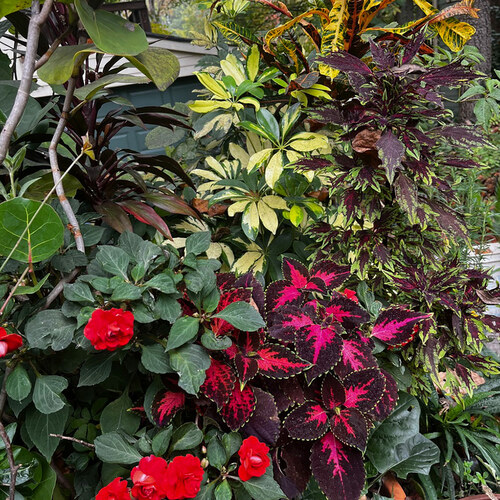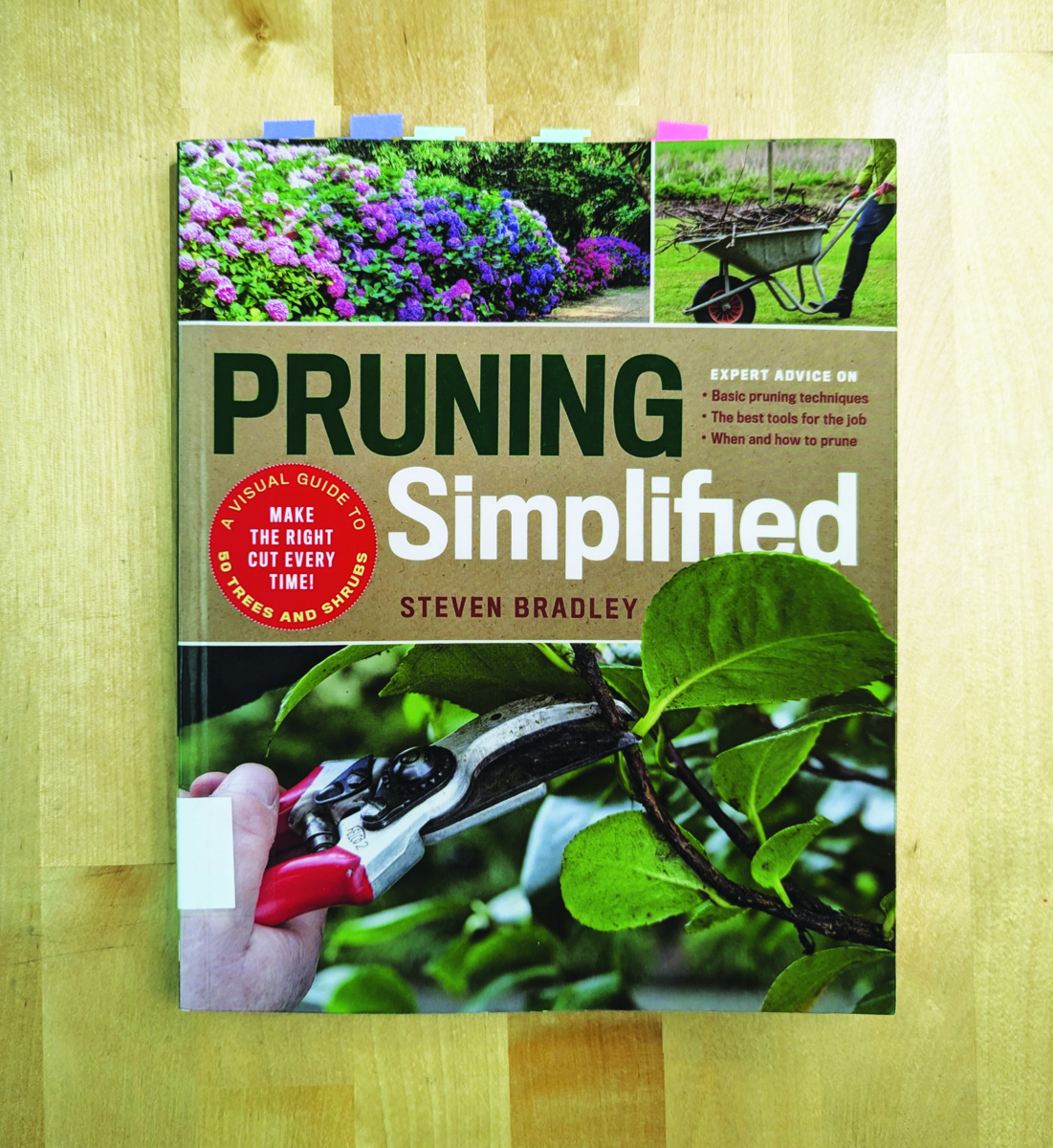
Hi GPODers!
For those unfamiliar, a few times this year I did “GPOD Vignettes.” These were compilation-style posts that featured a handful of short submissions (only a photo or two). Back in June, in the very first GPOD Vignette (check it out here), I featured a striking ‘Lemon Zest’ hydrangea (Hydrangea macrophylla ‘Lemon Zest’, Zones 4–7) submitted by an anonymous contributor. A few weeks ago, I was thrilled to get another email from that anonymous contributor. Steve Schmidt in Atlanta, Georgia not only revealed his identity, but also shared many more photos from his sensational garden.
My name is Steve Schmidt in Atlanta. I am the “mystery submitter” who sent the hydrangea “Lemon Zest” photo last June. I’m retired and trying to get a handle on gardening in these changing times – climate change and trying to be more ’native’. My backyard is roughly a quarter of an acre which is the floodplain for a stream which borders the back of the lot. The residence sits atop a very steep slope – 27 steps from the floodplain to the subbasement level – hence 2 more stories of height to get to the street level. The front of the residence faces south – hot with dry clay. Lots of shade in front, however, on residence side of the public sidewalk. (Power lines prevent anything truly shady between the sidewalk and street in the verge.) The back is pretty much all heavy shade (tall trees in floodplain and on the hillside above) except for a triangle-shaped area at the NE corner. When acquired the back was full of kudzu, privet, ivy, and cherry laurel.
I’ve pretty well tamed the non-native invasives in back (except for ivy on the steep slope and the kudzu which can creep over the stream). I’ve come around to concentrating on autumn to spring interest (accumulating berry plants for autumn, native azaleas for spring, yet to flesh out mid-winter ideas) as summertime with the humidity, gnats and mosquitoes can be a challenge to doing much work despite the shade providing relief from the hot sun! Initially I was planting what I liked, but have come around to planting native plants that I like (with some non-natives interspersed) and doing more research – plant habits vary widely depending on conditions. Paths in back are mostly laid out and set. My focus currently is on planting shrubs to create corridors and ‘rooms.’ In front of the residence my current approach is to have lots of color, almost all in pots, from spring to autumn for all the folks who walk by.
 So, as summer fades, the last couple of months are bearing fruit in backyard for the birds: Winterberries ‘Winter Gold’ & ‘Winter Red’ (Ilex verticillata ‘Winter Gold’ and ‘Winter Red’, Zones 3–9). Five other berry-producing shrubs are in back as well, only one mature enough to have produced berries this year.
So, as summer fades, the last couple of months are bearing fruit in backyard for the birds: Winterberries ‘Winter Gold’ & ‘Winter Red’ (Ilex verticillata ‘Winter Gold’ and ‘Winter Red’, Zones 3–9). Five other berry-producing shrubs are in back as well, only one mature enough to have produced berries this year.
 Strawberry bush (Euonymus americanus, Zones 6–9), which appeared on its own. I’ll let most things grow that appear on their own so that I can identify before deciding to keep or remove.
Strawberry bush (Euonymus americanus, Zones 6–9), which appeared on its own. I’ll let most things grow that appear on their own so that I can identify before deciding to keep or remove.
 I noticed this year for the first time the flowers on the ‘Shoal Creek’ chaste tree (Vitex agnus-castus ‘Shoal Creek’, Zones 6–9) left seeds – apparently appreciated by cardinals.
I noticed this year for the first time the flowers on the ‘Shoal Creek’ chaste tree (Vitex agnus-castus ‘Shoal Creek’, Zones 6–9) left seeds – apparently appreciated by cardinals.
Turning to the front yard: I’ve almost finished transitioning most of the tropicals I brought up from south Florida to go inside. Also, as we dip into the 30s I’ve taken cuttings from the annuals I wish to grow again. The following pictures are from the front in the last few weeks as annuals have reached their maximum growth for this year.
 In the front pot are a ‘King of Siam’ croton (Codiaeum variegatum ‘King of Siam’, Zones 10–11), ‘Kingswood Torch’ coleus (Solenostemon ‘Kingswood Torch’, Zones 10–11), heuchera (from a friend who moved – red veins washed out in brightness of sun), East Indian holly fern (Arachniodes simplicior ‘Variegata’, Zones 6–9) and creeping Jenny (Vitex agnus-castus ‘Shoal Creek’, Zones 6–9).
In the front pot are a ‘King of Siam’ croton (Codiaeum variegatum ‘King of Siam’, Zones 10–11), ‘Kingswood Torch’ coleus (Solenostemon ‘Kingswood Torch’, Zones 10–11), heuchera (from a friend who moved – red veins washed out in brightness of sun), East Indian holly fern (Arachniodes simplicior ‘Variegata’, Zones 6–9) and creeping Jenny (Vitex agnus-castus ‘Shoal Creek’, Zones 6–9).
 The pot behind the preceding has a begonia (also from friend who moved),‘El Brighto’ coleus (Coleus scutellarioides ‘El Brighto’, Zones 10–11), ‘Mrs Iceton’ croton (Codiaeum variegatum ‘Mrs Iceton’, Zones 10–11) & ‘Citronelle’ heuchera (Heuchera ‘Citronelle’, Zones 4–8). The heuchera and coleus being in full shade all summer aren’t as bright or colorful as they can be. Smaller pots with cuttings & rooting from existing plants are at the base – future plants for planting in the backyard. The plant with the larger leaves behind the pot is a Colombian petunia (Suessenguthia multisetosa, Zones 9–11) which was brought up from Florida along with the crotons. It must be wintered inside which I think robs it of the timing it needs to bloom.
The pot behind the preceding has a begonia (also from friend who moved),‘El Brighto’ coleus (Coleus scutellarioides ‘El Brighto’, Zones 10–11), ‘Mrs Iceton’ croton (Codiaeum variegatum ‘Mrs Iceton’, Zones 10–11) & ‘Citronelle’ heuchera (Heuchera ‘Citronelle’, Zones 4–8). The heuchera and coleus being in full shade all summer aren’t as bright or colorful as they can be. Smaller pots with cuttings & rooting from existing plants are at the base – future plants for planting in the backyard. The plant with the larger leaves behind the pot is a Colombian petunia (Suessenguthia multisetosa, Zones 9–11) which was brought up from Florida along with the crotons. It must be wintered inside which I think robs it of the timing it needs to bloom.
 The entry sidewalk is lined on both sides by pots, the east side being more colorful than the west side (which has three blueberry shrubs temporarily awaiting preparation of their spot in back). Five coleuses are in the following photo: for sure ‘El Brighto’ & ‘Kingswood Torch;’ the other 3 have been propagated year-to-year = perhaps ‘Vino’ (dark one), ‘Kong Red’ & ‘Flame Thrower Chili Pepper.’ A ‘Mamey’ croton buried in the ‘Kong’ coleus. ‘Gartenmeister’ fuchsia (Fuchsia ‘Gartenmeister’, Zones 9–11) to the side. In the front pot is a Florida Sunshine anise (Illicium parviflorum ‘Florida Sunshine’, Zones 6–9) rooting awaiting a good size to go into the ground somewhere!
The entry sidewalk is lined on both sides by pots, the east side being more colorful than the west side (which has three blueberry shrubs temporarily awaiting preparation of their spot in back). Five coleuses are in the following photo: for sure ‘El Brighto’ & ‘Kingswood Torch;’ the other 3 have been propagated year-to-year = perhaps ‘Vino’ (dark one), ‘Kong Red’ & ‘Flame Thrower Chili Pepper.’ A ‘Mamey’ croton buried in the ‘Kong’ coleus. ‘Gartenmeister’ fuchsia (Fuchsia ‘Gartenmeister’, Zones 9–11) to the side. In the front pot is a Florida Sunshine anise (Illicium parviflorum ‘Florida Sunshine’, Zones 6–9) rooting awaiting a good size to go into the ground somewhere!
 In the driveway – too steep so no vehicle! – are rows of pots to act as a screen for the basement level. Here an oakleaf hydrangea (Hydrangea quercifolia, Zones 5–9) is changing colors. Also in pots are a burgundy viburnum and ‘Popcorn’ viburnum (Viburnum plicatum f. plicatum ‘Popcorn’, Zones 5–9). Rounding out the top row is a powderpuff (Calliandra haematocephala, Zones 9–11) – brought up from Florida. In front are euphorbia, salvia and coleus.
In the driveway – too steep so no vehicle! – are rows of pots to act as a screen for the basement level. Here an oakleaf hydrangea (Hydrangea quercifolia, Zones 5–9) is changing colors. Also in pots are a burgundy viburnum and ‘Popcorn’ viburnum (Viburnum plicatum f. plicatum ‘Popcorn’, Zones 5–9). Rounding out the top row is a powderpuff (Calliandra haematocephala, Zones 9–11) – brought up from Florida. In front are euphorbia, salvia and coleus.
 Also crossing the driveway are a pot of seagrapes (Coccoloba uvifera, Zones 9–11) (from FL), double impatient, coleus ‘Kingswood Torch,’ variegated schefflera, coleus ‘Flamethrower Chili Pepper’ and a croton the name of which I can’t find (perhaps ‘Golden Bell’).
Also crossing the driveway are a pot of seagrapes (Coccoloba uvifera, Zones 9–11) (from FL), double impatient, coleus ‘Kingswood Torch,’ variegated schefflera, coleus ‘Flamethrower Chili Pepper’ and a croton the name of which I can’t find (perhaps ‘Golden Bell’).
 I really enjoy the critters in the yard. The Carolina anoles stay in front where there’s sun. Due to shade, moisture, and plenty of fallen trues there are plenty of salamanders. Of course, the usual assortment of birds, small mammals, snakes, etc.
I really enjoy the critters in the yard. The Carolina anoles stay in front where there’s sun. Due to shade, moisture, and plenty of fallen trues there are plenty of salamanders. Of course, the usual assortment of birds, small mammals, snakes, etc.
 Cloudless sulphur butterfly on a powderpuff flower.
Cloudless sulphur butterfly on a powderpuff flower.
 Gulf Fritillary butterfly on river oat grass (Chasmanthium latifolium, Zones 5–9).
Gulf Fritillary butterfly on river oat grass (Chasmanthium latifolium, Zones 5–9).
Thank you so much for sharing this farewell to summer, Steve! It was so great to learn more about you and your beautiful garden. I hope we get to see more updates in the future 🙂
And a reminder to everyone that you can start anywhere when submitting to Garden Photo of the Day. Though the directions below say to submit 5-10 photos, I will certainly except less and keep them on file until I have enough to compile another GPOD Vignette. Whether you have one photo to share or 20, please consider sending them over to [email protected] and your garden can be featured on the blog this winter.
Have a garden you’d like to share?
Have photos to share? We’d love to see your garden, a particular collection of plants you love, or a wonderful garden you had the chance to visit!
To submit, send 5-10 photos to [email protected] along with some information about the plants in the pictures and where you took the photos. We’d love to hear where you are located, how long you’ve been gardening, successes you are proud of, failures you learned from, hopes for the future, favorite plants, or funny stories from your garden.
Have a mobile phone? Tag your photos on Facebook, Instagram or Twitter with #FineGardening!
Do you receive the GPOD by email yet? Sign up here.
Fine Gardening Recommended Products

Planting in a Post-Wild World: Designing Plant Communities for Resilient Landscapes
Fine Gardening receives a commission for items purchased through links on this site, including Amazon Associates and other affiliate advertising programs.
Featuring gorgeous photography and advice for landscapers, Planting in a Post-Wild World by Thomas Rainer and Claudia West is dedicated to the idea of a new nature—a hybrid of both the wild and the cultivated—that can nourish in our cities and suburbs.

DeWalt Variable-Speed Cordless Reciprocating Saw
Fine Gardening receives a commission for items purchased through links on this site, including Amazon Associates and other affiliate advertising programs.
You can fit a variety of blades to this saw to cut fallen branches or prune larger limbs from trees in a pinch. It’s fast, tough, easy to use, and extremely versatile.
– 18.31 x 6.13 x 4 inches
– 1-1/8-inch stroke length
– Variable speed trigger with 0-3000 spm

Pruning Simplified: A Step-by-Step Guide to 50 Popular Trees and Shrubs
Fine Gardening receives a commission for items purchased through links on this site, including Amazon Associates and other affiliate advertising programs.
Pruning Simplified shows you exactly how to do it. This must-have guide offers expert advice on the best tools for the job, specific details on when to prune, and clear instructions on how to prune. Profiles of the 50 most popular trees and shrubs—including azaleas, camellias, clematis, hydrangeas, and more—include illustrated, easy-to-follow instructions that will ensure you make the right cut the first time.








